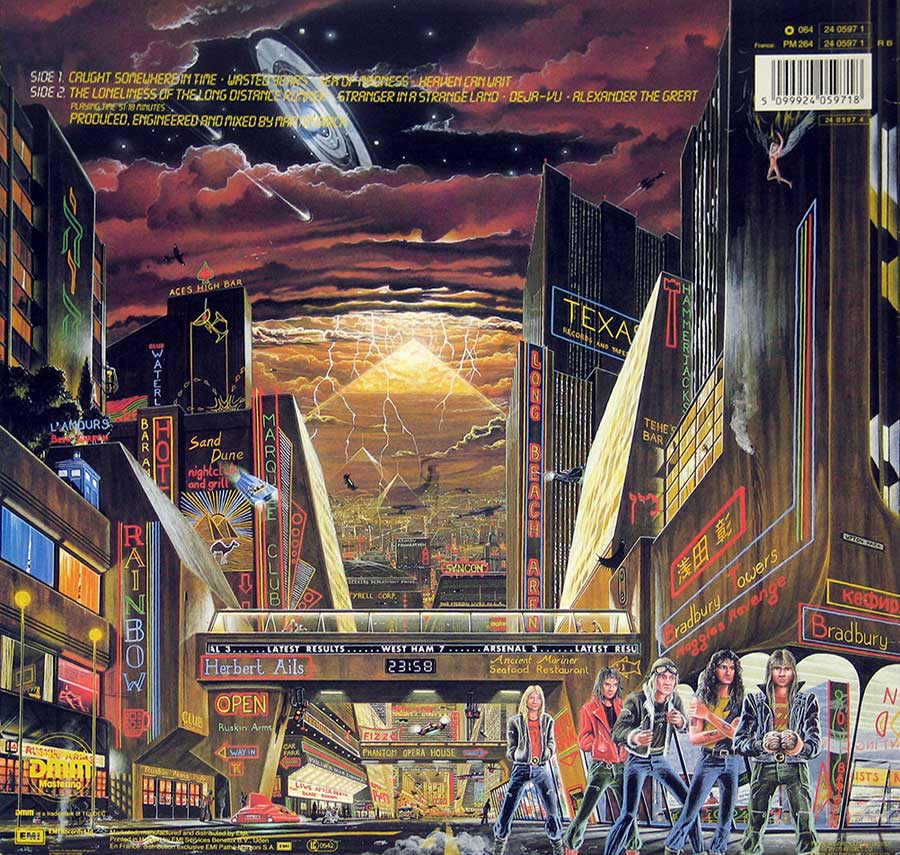"Somewhere in Time" Album Description:
Released in 1986, "Somewhere in Time" marked a bold evolution in Iron Maiden’s sound. Coming off the triumph of "Powerslave" and the marathon World Slavery Tour, the band traded ancient tombs for neon skylines — pushing heavy metal into a futuristic direction without losing its core power.
As their sixth studio album, it introduced guitar synthesizers for the first time, not traditional keyboards — a controversial leap that split fans at the time. Yet tracks like "Wasted Years" and "Stranger in a Strange Land" delivered both energy and emotion, proving that progress and melody could coexist in metal.
Recorded at Compass Point Studios in Nassau, Bahamas, and finished at Wisseloord Studios in the Netherlands, the sessions were guided by longtime producer Martin Birch. The production was meticulous, layering harmonized guitars, crisp vocals, and digital precision that reflected the era’s new recording technology.
The album’s futuristic concept wasn’t literal but aesthetic — captured vividly by Derek Riggs’s artwork, a time-traveling sci-fi vision of Eddie stalking through a cyberpunk city filled with hidden references to Maiden’s past. It perfectly mirrored the sense of ambition in the music itself.
Despite early criticism from purists, "Somewhere in Time" grew into a cornerstone of the band’s legacy. Its fusion of melody and power influenced countless later acts, while its sonic polish made it one of Maiden’s best-sounding albums of the 1980s.
Collectors prize the German DMM (Direct Metal Mastering) pressing for its remarkable clarity and depth — one of the finest ways to experience the album’s layered production in full analog glory.
“Somewhere in Time” – The European Triumph
When Iron Maiden unleashed “Somewhere in Time” in September 1986, Europe was ready for liftoff.
The neon-drenched future Derek Riggs had painted on the cover seemed to mirror the new, chrome-plated sound Martin Birch captured in the studio — sharp, precise, and oddly elegant.
The result wasn’t just another metal record; it was a continental phenomenon.
In West Germany, the album rocketed to #3 on the Media Control charts and held its ground for over twenty weeks.
For a genre still considered “too loud” by radio executives, that was an act of defiance wrapped in guitar solos.
The German pressings, especially the Direct Metal Mastering (DMM) version, became the audiophile favorite — the cleanest, most balanced Iron Maiden ever sounded on vinyl.
Within months, Somewhere in Time was certified Gold by the BVMI, confirming that a quarter-million Germans had no problem cranking up futuristic metal.
The Netherlands responded with equal enthusiasm. The album hit #3 on the Dutch Album Top 100 and camped there for nearly five months.
Dutch rock stations like Veronica and Hilversum 3 gave heavy rotation to “Wasted Years” and “Stranger in a Strange Land,” and when the band landed in Rotterdam and Utrecht later that year, tickets evaporated faster than beer in the Ahoy Arena.
Maiden had gone from cult heroes to cultural event — the kind of act that made turntable retailers suddenly run out of anti-static sleeves.
Critics grumbled about the synthesizers; fans didn’t care. The combination of Adrian Smith’s melodic writing and Steve Harris’s precision bass turned this album into the perfect storm —
half rebellion, half revelation. While the British press scratched its head, Europe simply dropped the needle and let the music do the talking.
By the end of 1986, Somewhere in Time had cemented Iron Maiden’s position as a global heavyweight.
The Germans praised the mastering, the Dutch praised the songwriting, and collectors everywhere praised the packaging — because Derek Riggs didn’t just paint an album cover; he built a city.
Decades later, the glow still hasn’t dimmed.
Written from the perspective of a vinyl collector who still believes that the 1986 German DMM pressing remains the definitive version — not because it’s rare, but because it sounds like the future, even now.



